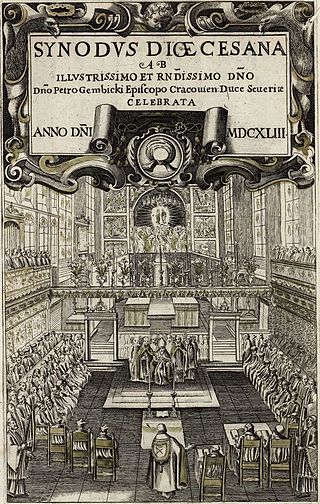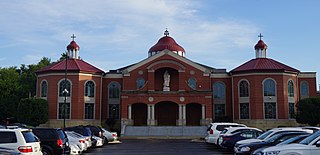The Roman Curia comprises the administrative institutions of the Holy See and the central body through which the affairs of the Catholic Church are conducted. The Roman Curia is the institution which the Roman Pontiff ordinarily makes use of in the exercise of his supreme pastoral office and universal mission in the world: thus curialism refers traditionally to an emphasis on the supreme authority of the Holy See within the Catholic Church. It is at the service of the Pope and bishops, fulfilling their function with an evangelical spirit, working for the good and at the service of communion, unity and edification of the Universal Church and attending to the demands of the world in which the Church is called to fulfill its duty and mission.

A synod is a council of a Christian denomination, usually convened to decide an issue of doctrine, administration or application. The word synod comes from the Ancient Greek σύνοδος 'assembly, meeting'; the term is analogous with the Latin word concilium'council'. Originally, synods were meetings of bishops, and the word is still used in that sense in Catholicism, Oriental Orthodoxy and Eastern Orthodoxy. In modern usage, the word often refers to the governing body of a particular church, whether its members are meeting or not. It is also sometimes used to refer to a church that is governed by a synod.

A prelate is a high-ranking member of the Christian clergy who is an ordinary or who ranks in precedence with ordinaries. The word derives from the Latin praelatus, the past participle of praeferre, which means 'carry before', 'be set above or over' or 'prefer'; hence, a prelate is one set over others.
An ecclesiastical court, also called court Christian or court spiritual, is any of certain non-adversarial courts conducted by church-approved officials having jurisdiction mainly in spiritual or religious matters. Historically, they interpret or apply canon law, a basis of which was the Corpus Juris Civilis of Justinian, which is also considered the source of the civil law legal tradition.

The Roman Catholic Bishop of Honolulu is the diocesan bishop of the Catholic Diocese of Honolulu in the United States, the Latin Church ecclesiastical territory over the entire state of Hawaii and the unincorporated Hawaiian Islands. The Honolulu diocese is a suffragan see in the ecclesiastical province administered by the metropolitan Archbishop of San Francisco. The Bishop of Honolulu is a member of the United States Conference of Catholic Bishops. He has two ecclesiastical seats: the Cathedral Basilica of Our Lady of Peace and the Co-Cathedral of Saint Theresa of the Child Jesus, both located in the City of Honolulu.

An ordinary is an officer of a church or civic authority who by reason of office has ordinary power to execute laws.
The hierarchy of the Catholic Church consists of its bishops, priests, and deacons. In the ecclesiological sense of the term, "hierarchy" strictly means the "holy ordering" of the church, the Body of Christ, so to respect the diversity of gifts and ministries necessary for genuine unity.

The Diocese of Westminster is a Latin archdiocese of the Catholic Church in England. The diocese consists of most of London north of the River Thames and west of the River Lea, the borough of Spelthorne, and the county of Hertfordshire, which lies immediately to London's north.

The Eparchy of St. Thomas Syro-Malabar Catholic of Chicago, also known as the St. Thomas Syro-Malabar Diocese of Chicago, is a Syro-Malabar Catholic Church ecclesiastical territory or eparchy of the Catholic Church in the United States. Its episcopal seat is the Mar Thoma Sleeha Cathedral in the episcopal see of Chicago.
A curia is an official body that governs an entity within the Catholic Church. These curias range from the relatively simple diocesan curia; to the larger patriarchal curias; to the curia of various Catholic particular churches; to the Roman Curia, which is the central government of the Catholic Church. Other Catholic bodies, such as religious institutes, may also have curias.
In the jurisprudence of the canon law of the Catholic Church, a dispensation is the exemption from the immediate obligation of the law in certain cases. Its object is to modify the hardship often arising from the rigorous application of general laws to particular cases, and its essence is to preserve the law by suspending its operation in such cases.
Cardinal vicar is a title commonly given to the vicar general of the Diocese of Rome for the portion of the diocese within Italy. The official title, as given in the Annuario Pontificio, is vicar general of His Holiness.
Ecclesiastical letters are publications or announcements of the organs of Roman Catholic ecclesiastical authority, e.g. the synods, but more particularly of pope and bishops, addressed to the faithful in the form of letters.

In the Catholic Church, a bishop is an ordained minister who holds the fullness of the sacrament of holy orders and is responsible for teaching doctrine, governing Catholics in his jurisdiction, sanctifying the world and representing the church. Catholics trace the origins of the office of bishop to the apostles, who it is believed were endowed with a special charism and office by the Holy Spirit at Pentecost. Catholics believe this special charism and office has been transmitted through an unbroken succession of bishops by the laying on of hands in the sacrament of holy orders.

The Roman Catholic Diocese of Pasig is the diocese of the Latin Church of the Catholic Church in the Philippines that comprises the cities of Pasig and Taguig, and the municipality of Pateros, in Metro Manila, Philippines. It was established by Pope John Paul II on June 28, 2003, by virtue of the papal bull Dei Caritas. It was formally and canonically erected on August 21, 2003, with the installation of Francisco C. San Diego as its first bishop. The Immaculate Conception Cathedral-Parish, located in the central vicinity of Pasig, was made the cathedral or the seat of the diocese.
In the Roman Catholic Church, a plenary council is any of various kinds of ecclesiastical synods, used when those summoned represent the whole number of bishops of some given territory. The word itself, derived from the Latin plenarium, hence concilium plenarium, also concilium plenum. Plenary councils have a legislative function that does not apply to other national synods.

The Diocese of Hexham and Newcastle is a Latin Church diocese of the Catholic Church, centred on St Mary's Cathedral in the city of Newcastle upon Tyne in England. The diocese is one of the six suffragan sees in the ecclesiastical Province of Liverpool and covers the historic boundaries of County Durham and Northumberland.

The Diocese of Rome, also called the Vicariate of Rome, is a Latin diocese of the Catholic Church under the direct jurisdiction of the Pope, who is Bishop of Rome and hence the supreme pontiff and head of the worldwide Catholic Church. As the Holy See, the papacy is a sovereign entity with diplomatic relations, and civil jurisdiction over the Vatican City State located geographically within Rome. The Diocese of Rome is the metropolitan diocese of the province of Rome, an ecclesiastical province in Italy. According to Catholic tradition, the first bishop of Rome was Saint Peter in the first century. The incumbent since 13 March 2013 is Pope Francis.

The Diocese of Novaliches is a diocese of the Latin Church of the Catholic Church in the Philippines. The diocese was created by Pope John Paul II on December 7, 2002, by virtue of his Apostolic Constitution Animarum Utilitati, and was canonically erected on January 16, 2003, from the Archdiocese of Manila. The diocese previously existed as the Ecclesiastical District of Quezon City-North, which was renamed the District of Novaliches in 2002.
This is a glossary of terms used within the Catholic Church. Some terms used in everyday English have a different meaning in the context of the Catholic faith, including brother, confession, confirmation, exemption, faithful, father, ordinary, religious, sister, venerable, and vow.











